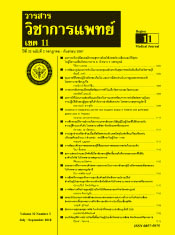สภาวะช่องปากและปัจจัยที่เกี่ยวข้องของผู้ติดเชื้อเอชไอวีตามระยะเวลาที่ได้รับยาต้านไวรัส ในโรงพยาบาลสมุทรปราการ
คำสำคัญ:
เอชไอวี, สภาวะช่องปาก, ระยะเวลาที่ได้รับยาต้านไวรัสบทคัดย่อ
การศึกษานี้เป็นการศึกษาแบบตัดขวางในผู้ติดเชื้อเอชไอวีที่รักษาด้วยยาต้านไวรัสที่ควบคุมโรคได้ดี 240 คนในโรงพยาบาลสมุทรปราการแบ่งเป็น 2 กลุ่มเท่าๆ กันคือ (1) กลุ่มได้รับยาระยะสั้น (น้อยกว่า 3 ปี) และ (2) กลุ่มได้รับยาระยะยาว (มากกว่าหรือเท่ากับ 3 ปี) เก็บข้อมูลส่วนบุคคลโดยใช้แบบสอบถามชนิดตอบเองและการตรวจช่องปากโดยผู้ตรวจเพียงคนเดียวทำการตรวจประเมินฟันผุ ถอน อุด (Decayed, missing and filled teeth index; DMFT) และประเมินสภาวะปริทันต์ตามดัชนีซีพีไอ (Community periodontal index;CPI) ผลการศึกษาพบว่ากลุ่มตัวอย่าง ส่วนใหญ่เป็นเพศชาย127คน (ร้อยละ52.9) อายุเฉลี่ย 42.2 ปี กลุ่มที่ได้รับยาระยะยาวมีโรคฟันผุสูงกว่ากลุ่มที่ได้รับยาระยะสั้น (ร้อยละ 64.2 และ ร้อยละ 51.7 ตามลำดับ)อย่างมีนัยสำคัญทางสถิติ (p= 0.049) แต่ทั้งสองกลุ่มมีโรคปริทันต์ไม่ต่างกัน ซึ่งในกลุ่มได้รับยาระยะสั้นพบปัจจัยที่มีความสัมพันธ์ต่อโรคฟันผุ คืออายุและรายได้(p=0.016,และ p=0.012ตามลำดับ) ส่วนปัจจัยที่มีความสัมพันธ์ต่อโรคปริทันต์ได้แก่อายุและการเป็นโรคความดันโลหิตสูง (p<0.001,p=0.011ตามลำดับ) สำหรับกลุ่มได้รับยาระยะยาวไม่มีปัจจัยใดที่สัมพันธ์ต่อโรคฟันผุ แต่ระดับการศึกษา การเป็นโรคความดันโลหิตสูงและการใช้น้ำยาบ้วนปากมีความสัมพันธ์ต่อโรคปริทันต์ (p=0.034,0.004 และ 0.006 ตามลำดับ) การศึกษานี้สรุปได้ว่าระยะเวลาที่ผู้ติดเชื้อเอชไอวีได้รับยาต้านไวรัสมีความสัมพันธ์กับโรคฟันผุ ในกลุ่มได้รับยาระยะสั้นอายุเป็นปัจจัยที่มีความสัมพันธ์ทั้งต่อโรคฟันผุ แลโรคปริทันต์ การเป็นโรคความดันโลหิตสูงเป็นปัจจัยที่มีความสัมพันธ์ต่อโรคปริทันต์ทั้งในกลุ่มได้รับยาระยะสั้นและระยะยาว
References
สุขภาพแห่งชาติ;2560. เข้าถึงได้จากhttps://www.nhso.go.th/files/userfiles/Download/2017.(สืบค้นเมื่อ2 ธันวาคม 2560)
Lederman MM. Immune restoration and CD4+T-cell function with antiretroviral therapies.AIDS; 2001;15(Suppl. 2):S11–5.
Ramirez-Amador V, Esquivel-PedrazaL,Sierra-Madero J, Anaya-Saavedra G,Gonzalez-Ramirez L, Ponce-de-Leon S.The changing clinical spectrum of human immunodeficiency virus (HIV)-related oral lesions in 1000 consecutive
patients:a 12-year study in a referral center in Mexico. Medicine (Baltimore);2003;82(1):39–50.
Nittayananta W, Chanowanna N, Jealae S, Nauntofte B, Stoltze K. Hyposalivation,xerostomia and oral health status of HIV-infected subjects in Thailand before HAART era. J Oral Pathol Med; 2010;39:28-34
Bretz WA, Flaitz C, Moretti A, Corby P,Schneider LG, Nichols CM. Medication usage and dental caries outcome-
related variables in HIV/AIDS patients.AIDS Patient Care STDs. 2000;14:549–54.
Loghman RS, Poorandokht D, Hamid RA,Mina J, Hossein M. Dental Caries Prevalence in Human Immunodeficiency
Virus Infected Patients Receiving Highly Active Anti-Retroviral Therapy in Ker-mans hah, Iran.Cell J; 2014;16(1):73-78.
Ceballos-Salobrena A, Gaitan-CepedaL A, Ceballos-Garcia L, Lezama-Del Valle D. Oral lesions in HIV / AIDS patients undergoing highly active antiretroviral treatment including protease inhibitors: a new f ace of oral AIDS? AIDS Patient Care STDS; 2000;14:627–35.
Fricke U, Geurtsen W, Staufenbiel I,Rahman A. Periodontal status of HIV-infected patients undergoing antiretroviral
therapy compared to HIV-therapy naive patients:a case control study. Eur J Med Res; 2012; 17(1): 2.
World Health Organization. Oral Health Survey : Basic Method 5 th Edition World health org, 2013.Available
from :https://www.who.int/oral_health/publications/9789241548649/en.(cited 2017 May 5)
Nittayananta W, Talungchit S, Jarura-tanasirikul S, Silpapojakul K, Chayakul P,Nilmanat A, et al. Effects of long-termuse of HAART on oral health status of HIV-infected subjects. J Oral Pathol Med; 2010;39(5):397-406.
Glick M, Berthold P, Danik J. Severe caries and the use of protease inhibitors.J Dent Res; 1998; 77(Suppl. 1):84-84
Phelan JA, Mulligan R, Nelson E,Brunelle J, Alves ME, Navazesh M, et al.Dental caries in HIV-seropositive women.
J Dent Res; 2004;83(11):869–873.
Medina-Torne S, Ganesan A, Barahona I,Crum-Cianflone NF. Hypertension is common among HIV-infected persons,but not associated with HAART. J. Int Assoc Physicians AIDS Care; 2012;11 (1):20-5.
Kawabata Y, Ekuni D, Miyai H, Kataoka K, Yamane M. Relationship Between Prehypertension/Hypertension
and Periodontal Disease: A Prospective Cohort Study.Am J Hypertens; 2016; 29(3);388-96.
Nonzee V, Manopatanakul S, Khovidhunkit SO.Xerostomia, hyposalivation and oral microbiota in patients using anti-hypertensive medications.J Med Assoc Thai; 2012; 95(1):96-104.





